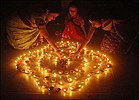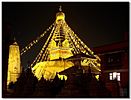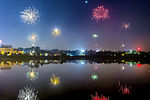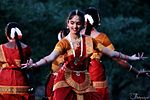DIWALI
Diwali
Diwali honors the victory of good over evil and brightness over darkness. It celebrates Lord Ram and his wife Sita returning to their kingdom of Ayodhya, following the defeat of Ravan and rescue of Sita on Dussehra. It's known as the "Festival of Lights" for all the fireworks, small clay lamps, and candles that are lit to guide their way. For Indian Hindu families, Diwali is the most anticipated festival of the year.
Diwali, the festival of lights is indeed the most awaited and the most celebrated festivals of India. People in every nook and cranny of the country welcome the festival with enthusiastic gestures. This wonderful festival is the celebration of five days. On the third day of the celebratory occasion, the key rituals of the Diwali festival take place. Lighting of Diyas and candles all around the house, worshipping the Laxmi Ganesha to summon health and wealth and bursting crackers are the chief rituals of the festival.
| |||||||||||||
Dates
The five-day celebration is observed every year in early autumn after the conclusion of the summer harvest. It coincides with the new moon (amāvasyā) and is deemed the darkest night of the Hindu lunisolar calendar. The festivities begin two days before amāvasyā, on Dhanteras, and extend two days after, until the second (or 17th) day of the month of Kartik.[48] (According to Indologist Constance Jones, this night ends the lunar month of Ashwin and starts the month of Kartik[– but see this note[c] and Amanta and Purnima systems.) The darkest night is the apex of the celebration and coincides with the second half of October or early November in the Gregorian calendar.[ The festival climax is on the third day and is called the main Diwali. It is an official holiday in a dozen countries, while the other festive days are regionally observed as either public or optional restricted holidays in India. In Nepal, it is also a multiday festival, although the days and rituals are named differently, with the climax being called the Tihar festival by Hindus and Swanti festival by Buddhists.[52][53]
History
Diwali was also described by numerous travelers from outside India. In his 11th-century memoir on India, the Persian traveler and historian Al Biruni wrote of Deepavali being celebrated by Hindus on the day of the New Moon in the month of Kartika The Venetian merchant and traveler Niccolò de' Conti visited India in the early 15th-century and wrote in his memoir, "on another of these festivals they fix up within their temples, and on the outside of the roofs, an innumerable number of oil lamps... which are kept burning day and night" and that the families would gather, "clothe themselves in new garments", sing, dance and feast.The 16th-century Portuguese traveler Domingo Paes wrote of his visit to the Hindu Vijayanagara Empire, where Dipavali was celebrated in October with householders illuminating their homes, and their temples, with lamps. It is mentioned in the Ramayana that Diwali was celebrated for only 2 years in Ayodhya.
Jain inscriptions, such as the 10th-century Saundatti inscription about a donation of oil to Jinendra worship for the Diwali rituals, speak of Dipotsava.Another early 13th-century Sanskrit stone inscription, written in the Devanagari script, has been found in the north end of a mosque pillar in Jalore, Rajasthan evidently built using materials from a demolished Jain temple. The inscription states that Ramachandracharya built and dedicated a drama performance hall, with a golden cupola, on Diwali.[76][77][i]
Religious significance
The religious significance of Diwali varies regionally within India. One tradition links the festival to legends in the Hindu epic Ramayana, where Diwali is the day Rama, Sita, Lakshman and Hanuman reached Ayodhya after a period of 14 years in exile after Rama's army of good defeated demon king Ravana's army of evil.[78] Throughout the epic, Rama's decisions were always in line with dharma (duty) and the Diwali festival serves as a reminder for followers of hinduism to maintain their dharma in day to day life.[79]
Per another popular tradition, in the Dvapara Yuga period, Krishna, an avatar of Vishnu, killed the demon Narakasura, who was the evil king of Pragjyotishapura, near present-day Assam, and released 16000 girls held captive by Narakasura. Diwali was celebrated as a signifier of triumph of good over evil after Krishna's Victory over Narakasura. The day before Diwali is remembered as Naraka Chaturdasi, the day on which Narakasura was killed by Krishna.
Many Hindus associate the festival with Goddess Lakshmi, the goddess of wealth and prosperity, and wife of Vishnu. According to Pintchman, the start of the 5-day Diwali festival is stated in some popular contemporary sources as the day Goddess Lakshmi was born from Samudra manthan, the churning of the cosmic ocean of milk by the Devas (gods) and the Asuras (demons) – a Vedic legend that is also found in several Puranas such as the Padma Purana, while the night of Diwali is when Lakshmi chose and wed Vishnu.[Along with Lakshmi, who is representative of Vaishnavism, Ganesha, the elephant-headed son of Parvati and Shiva of Shaivism tradition, is remembered as one who symbolises ethical beginnings and the remover of obstacles.[78]
Hindus of eastern India associate the festival with the Goddess Kali, who symbolises the victory of good over evil. Hindus from the Braj region in northern India, parts of Assam, as well as southern Tamil and Telugu communities view Diwali as the day the god Krishna overcame and destroyed the evil demon king Narakasura, in yet another symbolic victory of knowledge and good over ignorance and evil.
Trade and merchant families and others also offer prayers to Saraswati, who embodies music, literature and learning and Kubera, who symbolises book-keeping, treasury and wealth management.[41] In western states such as Gujarat,and certain northern Hindu communities of India, the festival of Diwali signifies the start of a new year.
Mythical tales shared on Diwali vary widely depending on region and even within Hindu tradition,yet all share a common focus on righteousness, self-inquiry and the importance of knowledge,[which, according to Lindsey Harlan, an Indologist and scholar of Religious Studies, is the path to overcoming the "darkness of ignorance".[90] The telling of these myths are reminiscent of the Hindu belief that good ultimately triumphs over evil.
External links
 The dictionary definition of Diwali at Wiktionary
The dictionary definition of Diwali at Wiktionary Media related to Diwali at Wikimedia Commons
Media related to Diwali at Wikimedia Commons Quotations related to Diwali at Wikiquote
Quotations related to Diwali at Wikiquote- The Ancient Origins of Diwali, India’s Biggest Holiday, Becky Little (2017)
- Deepawali
:max_bytes(150000):strip_icc():format(webp)/GettyImages-1365158541-5c319808c9e77c000157ed88.jpg)















Comments
Post a Comment